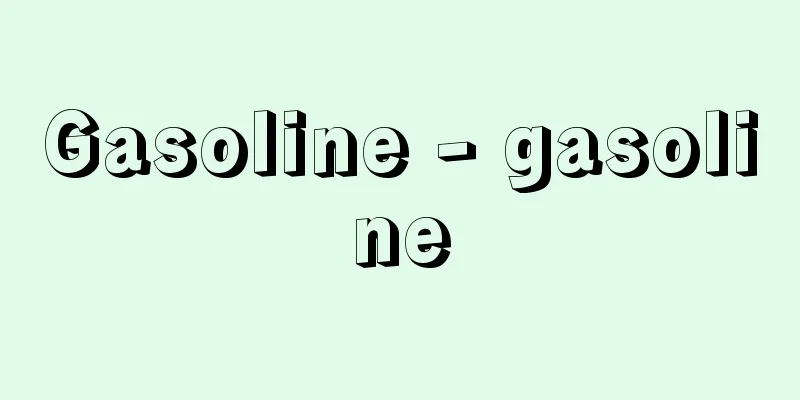Gasoline - gasoline

|
A petroleum product with a relatively low boiling point. Its boiling point ranges from about 25 to 200°C, and it is mainly used as fuel for gasoline engines (spark ignition engines). Some of it is used as a solvent. It is produced through the distillation of crude oil and thermal and chemical processing, and although it varies depending on the properties of the crude oil, the production method, and the application, it is generally a mixture of various hydrocarbons such as paraffin, naphthene, aromatic, and olefin. Depending on the application, it is broadly classified into automobile gasoline, aviation gasoline, and industrial gasoline. There are also a wide variety of gasoline depending on the production method, and these are appropriately mixed to make products depending on the application. The most important property for automobile and aviation gasoline is good anti-knock properties, i.e. a high octane number, and gasoline production methods are mainly based on this point. [Hara Nobuyoshi] Major gasoline types by production method(1) Straight-run gasoline: Gasoline obtained only by distilling crude oil, which was the main source of gasoline before World War II. However, in modern high-performance engines, the octane rating is too low to be used as is, so this unrefined gasoline fraction is called naphtha, and high-octane gasoline is produced by chemical processes such as naphtha reforming and isomerization. However, the fraction of naphtha with a boiling point of less than about 100°C (light naphtha) has an octane rating of about 60 to 75 (research method), and cannot be used as gasoline for automobiles on its own, but it is refined into straight-run light gasoline, which is used as a blending material for regular gasoline. (2) Isomerized gasoline: Light, high-octane gasoline made by isomerizing the n -paraffin, the main component, of light naphtha using a catalyst to convert it into isoparaffin. Its octane number is significantly higher than that of straight-run light gasoline, reaching approximately 85 or more, making it a material for high-octane gasoline. (3) Reformulated gasoline: A high-octane gasoline made by using heavy naphtha (boiling point: 80-200°C), which has a particularly low octane rating, as a raw material and changing its chemical structure using a catalyst; it is used as the main ingredient in automobile gasoline. Octane rating: 95 or higher. The main reaction in reforming is the dehydrogenation and aromatization of naphthenic hydrocarbons, and the main component is aromatic hydrocarbons with an extremely high octane rating. This reforming process is also used in the production of petrochemical raw materials such as benzene, toluene, and xylene. (4) Catalytic cracking gasoline: High-octane gasoline obtained by thermal cracking (cracking) heavy diesel fuel using a catalyst as the main raw material. Along with reformed gasoline, it is used as a fuel for automobiles. It contains a lot of isoparaffins and isoolefins, and has an octane number of about 92 or more. (5) Thermal cracking gasoline: Gasoline obtained by thermal cracking of heavy petroleum fractions without a catalyst. Its octane number is much lower than that of catalytic cracking gasoline, and currently the amount produced is extremely small. It is used by blending it with high-octane gasoline. (6) Hydrocracked gasoline: High-octane gasoline obtained by thermally cracking heavy petroleum fractions using a catalyst under hydrogen pressure. It is a product of catalytic cracking with the addition of hydrogenation, and has the advantage that inferior heavy oil can be used as a feedstock, with an octane number of approximately 85 or more. Unlike catalytic cracked gasoline, it does not contain olefins and is stable, making it suitable for use as a gasoline material for automobiles. (7) Alkylate: Synthetic high-octane gasoline obtained by alkylating isobutane with propylene, butylene, etc. A mixture of various isoparaffin hydrocarbons with an octane number of about 95 or more. Used as the main ingredient in aviation gasoline. (8) Polymerized gasoline: Gasoline obtained by polymerizing propylene, butylene, etc. using a catalyst. The main component is a mixture of various isoolefin hydrocarbons, with an octane number of approximately 85 or more. It is used as a blending material for automobile gasoline, but is not produced in Japan. (9) Natural gasoline: Liquid components (such as pentane) contained in wet natural gas are separated and extracted, and are mainly used as a solvent to produce industrial gasoline. [Hara Nobuyoshi] Automobile gasolineThe main ingredient is reformulated gasoline, which is appropriately mixed with catalytic cracking gasoline and straight-run light gasoline to produce standard and premium gasoline with different octane levels. Stabilizers (antioxidants) and anti-knock agents (tetraethyl lead, tetramethyl lead, etc.) are added as necessary to produce the final product. In Japan, the octane number (research method) of these gasolines is set at 85 or more for standard gasoline and 95 or more for premium gasoline. The properties required for automobile gasoline include a high octane number (anti-knock property), neutrality and non-corrosiveness, stability and non-gum formation, good vaporization properties, and an appropriate vapor pressure that does not cause vapor lock in the engine. Due to the harmful effects of lead compounds in the exhaust gas caused by the addition of anti-knock agents (lead), the trend toward low-lead or lead-free gasoline is progressing worldwide. In Japan, the amount of anti-knock agents added to automobile gasoline is limited to 0.03% by volume or less, and they are not added to standard gasoline and some premium gasoline. Leaded gasoline is dyed orange to indicate that it contains lead. [Hara Nobuyoshi] Aviation gasolineGasoline for propeller aircraft, mainly alkylate, blended with reformed gasoline, catalytic cracking gasoline, etc., with anti-knock agents added. The boiling point range is about 25-150°C, lower than automotive gasoline. Most aviation gasoline has an octane number of 100 or more, and its octane number is roughly proportional to the maximum power output. It is indicated by the power output number (Aviation Law/Turbocharging Law), and the main products are two types, with power output numbers of 100/130 (No. 2) and 115/145 (No. 3). The amount of lead (JIS K2206) is more than for automotive use, at 0.122% by volume or less, and the above two types of gasoline are dyed green and purple to indicate the lead and its rank, respectively. [Hara Nobuyoshi] Industrial gasolineGasoline used mainly as a solvent, also known as volatile oil. A wide variety of products are produced by refining appropriate fractions of natural gasoline, straight-run gasoline, etc., depending on the purpose. It is a mixture of various hydrocarbons, and the low-boiling ones in particular contain a lot of paraffinic components. The main ones are used for oil extraction from soybeans and other fats (boiling point 60-90°C), rubber solvent (80-160°C), paint (30-205°C), cleaning (150-210°C), general-purpose solvent petroleum benzine (30-150°C), as well as ligroin and petroleum ether, which are low-boiling solvents for laboratory use. [Hara Nobuyoshi] [Reference] | | | |Source: Shogakukan Encyclopedia Nipponica About Encyclopedia Nipponica Information | Legend |
|
比較的低沸点の炭化水素組成をもつ石油製品。沸点範囲は約25~200℃で、おもにガソリンエンジン(火花点火機関)の燃料となる。一部は溶剤として用いられる。原油の蒸留や熱的・化学的処理を経て製造され、原油の性状、製造法、用途別によって異なるが、一般にパラフィン系、ナフテン系、芳香族系、オレフィン系など各種炭化水素の混合物である。用途により、自動車ガソリン、航空ガソリン、工業ガソリンに大別される。また製造法によりきわめて多種類のガソリンがあり、用途によりこれらを適宜配合して製品とする。自動車および航空ガソリンとしてもっとも重要な性質は、アンチノック性がよいこと、すなわちオクタン価が高いことで、ガソリン製造法も、主としてこの点に基本が置かれている。 [原 伸宜] 製造法別による主要なガソリン(1)直留ガソリン 原油の蒸留のみで得られるガソリンで、第二次世界大戦前はこれがガソリンの主体であった。しかし現代の高性能エンジンではオクタン価が低すぎて、このままでは使用できず、この未精製のガソリン留分をナフサとよび、ナフサの改質、異性化などの化学的処理により高オクタン価ガソリンとしている。しかしナフサのうち沸点約100℃以下の留分(軽質ナフサ)はオクタン価が60~75程度(リサーチ法)であり、これ単独では自動車ガソリンとして使用できないが、精製して直留軽質ガソリンとし、並級(レギュラー)ガソリンへの配合材として用いられる。 (2)異性化ガソリン 軽質ナフサを触媒により、主成分のn‐パラフィンをイソパラフィンに異性化させた軽質の高オクタン価ガソリン。直留軽質ガソリンよりもオクタン価は著しく上昇し、約85以上となり、高オクタン価ガソリン材料となる。 (3)改質ガソリン ナフサのうちとくにオクタン価の低い重質ナフサ(沸点約80~200℃)を原料とし、触媒を用いてその化学構造を変えた高オクタン価ガソリンで、自動車ガソリンの主材料として用いられる。オクタン価約95以上。改質の主反応はナフテン系炭化水素の脱水素芳香族化で、オクタン価がきわめて高い芳香族炭化水素を主成分とする。なおこの改質操作は、石油化学原料のベンゼン、トルエン、キシレンなどの製造法にも利用される。 (4)接触分解ガソリン 重質軽油を主原料とし、触媒を用いて熱分解(クラッキング)して得られる高オクタン価ガソリンで、改質ガソリンとともに自動車ガソリン材料となる。イソパラフィン、イソオレフィンを多く含み、オクタン価約92以上。 (5)熱分解ガソリン 石油重質留分を無触媒で熱分解して得られるガソリンで、オクタン価は接触分解ガソリンよりもはるかに低く、現在では生産量はきわめて少ない。高オクタン価ガソリンに配合して使用される。 (6)水素化分解ガソリン 石油重質留分を水素加圧下に触媒を用いて熱分解して得られる高オクタン価ガソリン。接触分解に水素化を加味したもので、劣質重油を原料に使用できる特徴があり、オクタン価約85以上。接触分解ガソリンと異なり、オレフィン分を含まず安定で、自動車ガソリン材料となる。 (7)アルキレート イソブタンをプロピレン、ブチレンなどによりアルキル化して得られる合成高オクタン価ガソリン。各種イソパラフィン炭化水素の混合物でオクタン価約95以上。航空ガソリンの主材料に用いられる。 (8)重合ガソリン プロピレン、ブチレンなどを触媒を用い重合して得られるガソリン。主成分は各種イソオレフィン炭化水素の混合物で、オクタン価約85以上。自動車ガソリン配合材となるが、日本では生産されていない。 (9)天然ガソリン 湿性天然ガスに含まれる液状成分(ペンタンなど)を分離採取したもので、おもに溶剤として工業ガソリン材料となる。 [原 伸宜] 自動車ガソリン改質ガソリンを主とし、これに接触分解ガソリン、直留軽質ガソリンなどを適宜配合して、オクタン価レベルの異なる並級および特級(プレミアム)ガソリンの材料とし、必要に応じてさらに安定剤(酸化防止剤)、アンチノック剤(テトラエチル鉛、テトラメチル鉛など)を添加して製品とする。日本の規格ではこれらのガソリンのオクタン価(リサーチ法)は並級85以上、特級95以上に定められている。自動車ガソリンに要求される性質としては、オクタン価(アンチノック性)が高いことのほか、中性で腐食性がないこと、安定でガム質を生成しないこと、気化性がよいこと、蒸気圧が適当でエンジンのベーパーロック(蒸気閉塞(へいそく))をおこさないことなどである。なおアンチノック剤の添加(加鉛)による排気中の鉛化合物の有害性により、世界的にガソリンの低鉛化ないし無鉛化が進んでおり、日本の規格(JIS K2202)では、自動車ガソリンのアンチノック剤添加量は0.03容量%以下に制限されており、並級ガソリンと一部の特級ガソリンには添加されていない。加鉛ガソリンには染料でオレンジ色に着色して加鉛の表示としている。 [原 伸宜] 航空ガソリンプロペラ機用のガソリンで、アルキレートを主とし、これに改質ガソリン、接触分解ガソリンなどを配合し、アンチノック剤を添加して製品とする。沸点範囲は約25~150℃で、自動車ガソリンよりも低い。航空ガソリンのオクタン価は100以上のものが主体で、そのオクタン価はほぼ最高出力に比例する。出力価(航空法/過給法)で示され、主要な製品は出力価100/130(2号)および115/145(3号)の2種である。加鉛量(JIS K2206)は自動車用より多く、0.122容量%以下で、前記2種のガソリンには加鉛とそのランク表示にそれぞれ染料で緑と紫色に着色されている。 [原 伸宜] 工業ガソリンおもに溶剤として用いられるガソリンで、揮発油ともいう。天然ガソリン、直留ガソリンなどの適当な留分を精製して、用途により多種類の製品が製造されている。各種炭化水素の混合物で、とくに低沸点のものはパラフィン系成分が多い。主要なものはダイズなどの油脂抽出用(沸点60~90℃)、ゴム溶剤用(80~160℃)、塗料用(30~205℃)、クリーニング用(150~210℃)、一般用溶剤の石油ベンジン(30~150℃)などのほか、実験室用低沸点溶剤のリグロイン、石油エーテルなどがある。 [原 伸宜] [参照項目] | | | |出典 小学館 日本大百科全書(ニッポニカ)日本大百科全書(ニッポニカ)について 情報 | 凡例 |
<<: Gasoline engine - gasoline engine
Recommend
praxis
…Incidentally, the English word theater comes fro...
pitṛ-yāna (English spelling) pitryana
…Which one is reborn as depends on the amount of ...
Cut inlay - Kirihamezougan
...The technique of inlaying other materials (som...
Hired bus service - Kashikiri Bus (English name)
A bus that charters transportation by vehicle acco...
Microfilament
…Some spirochetes contain antigenic proteins simi...
Kandara - Kandara
...Since a large number of mackerel are caught at...
Tartar Zaibatsu
The largest conglomerate in India, it is at the he...
The Best Years of Our Lives
American film. 1946. Directed by William Wyler. A...
Henricia nipponica (English spelling)
An echinoderm of the family Asteroidea, class Aste...
《Papier-mache dog》
...The adaptation's approach transfers the er...
Kokubu [city] - Kokubu
An old city in the north of Kagoshima Bay, in the ...
Pelvic fibrosis - pelvic fibrosis
An infectious disease seen in women, it is a cellu...
Deer antler apple - Kazunoringo
...The alluvial plains of the rivers have been co...
King George [Island] - King George
...It has an area of about 4,700 km2. It is loc...
Ruiyoushouma - Ruiyoushouma
A perennial plant of the Ranunculaceae family that...









